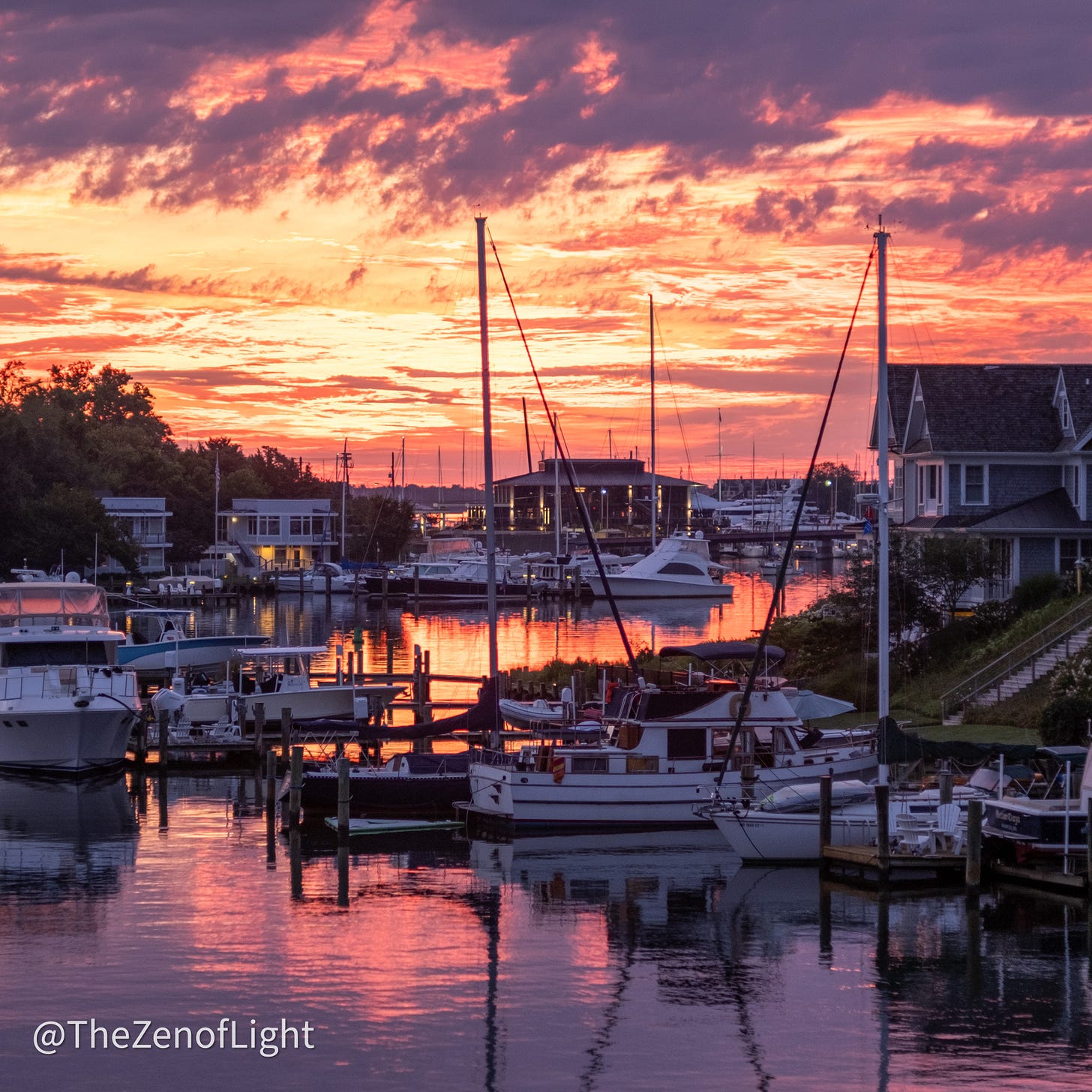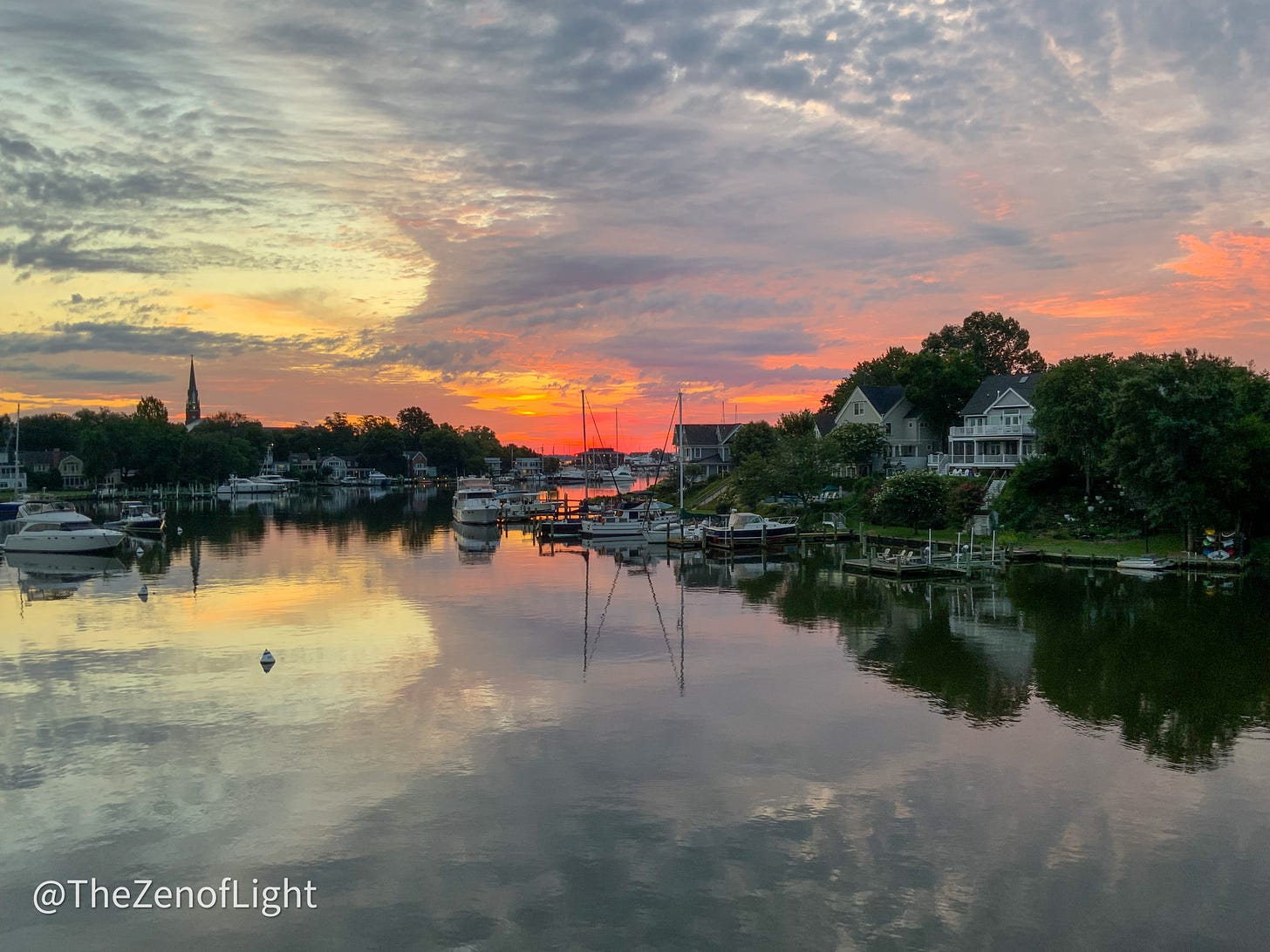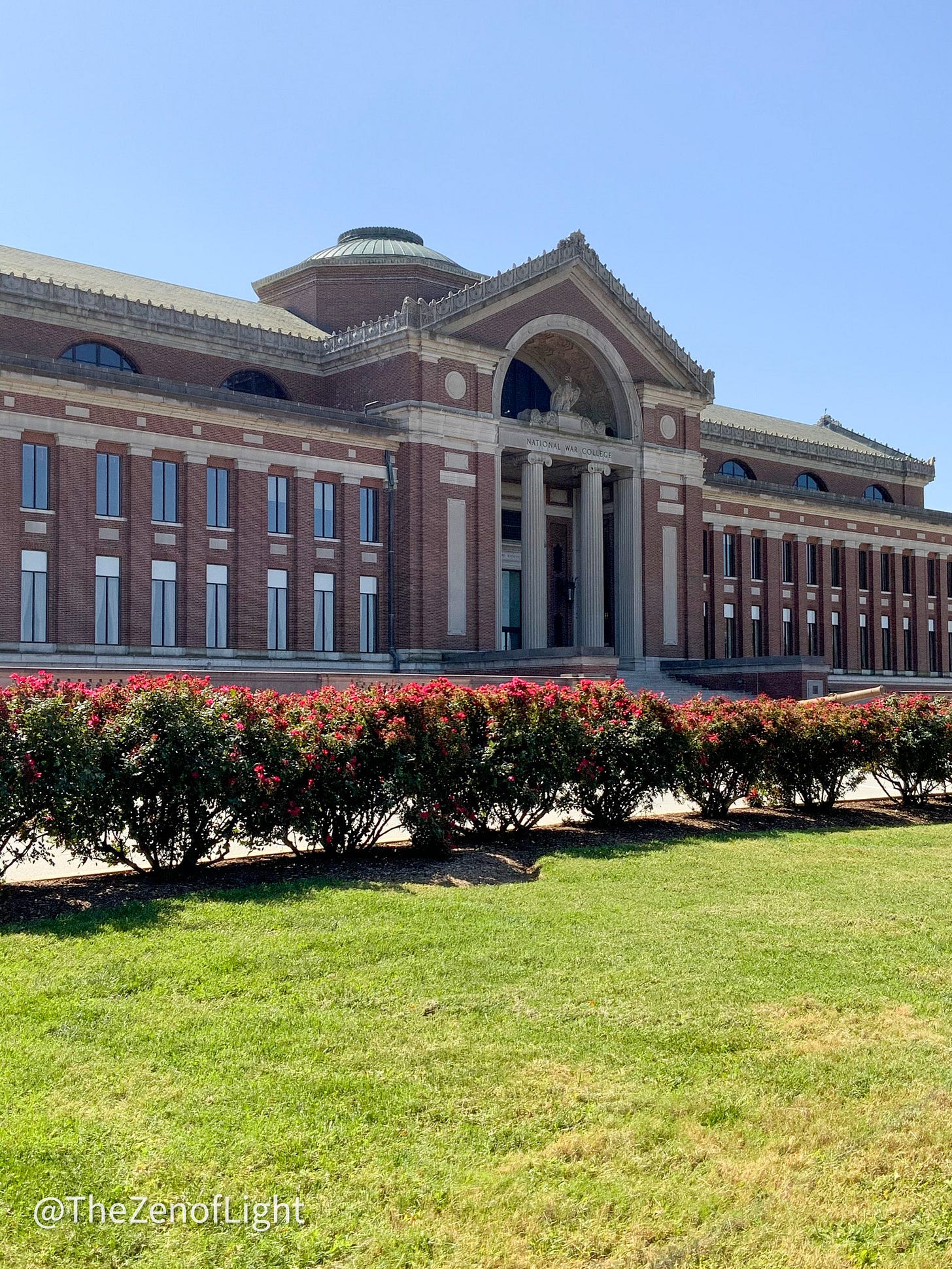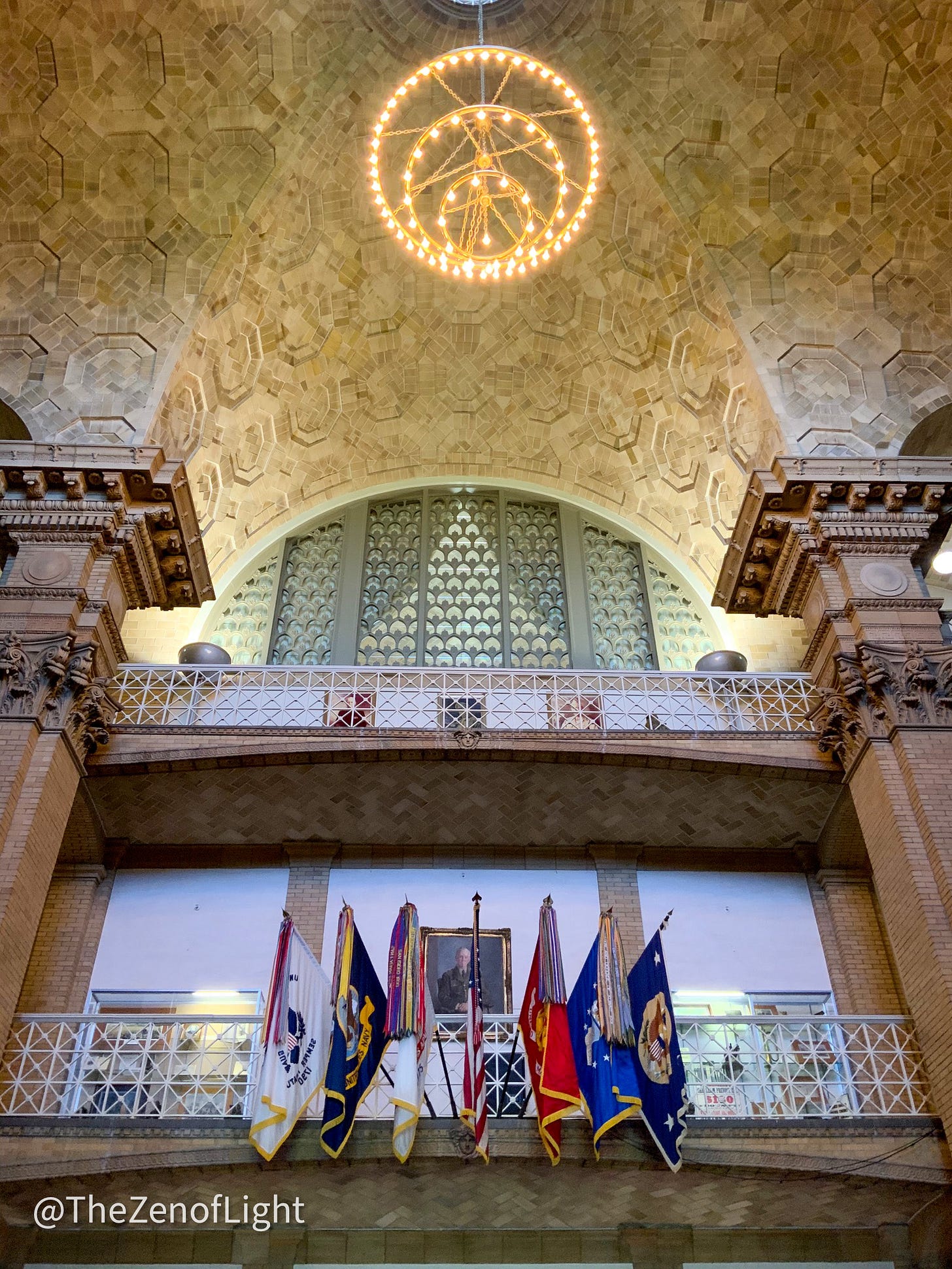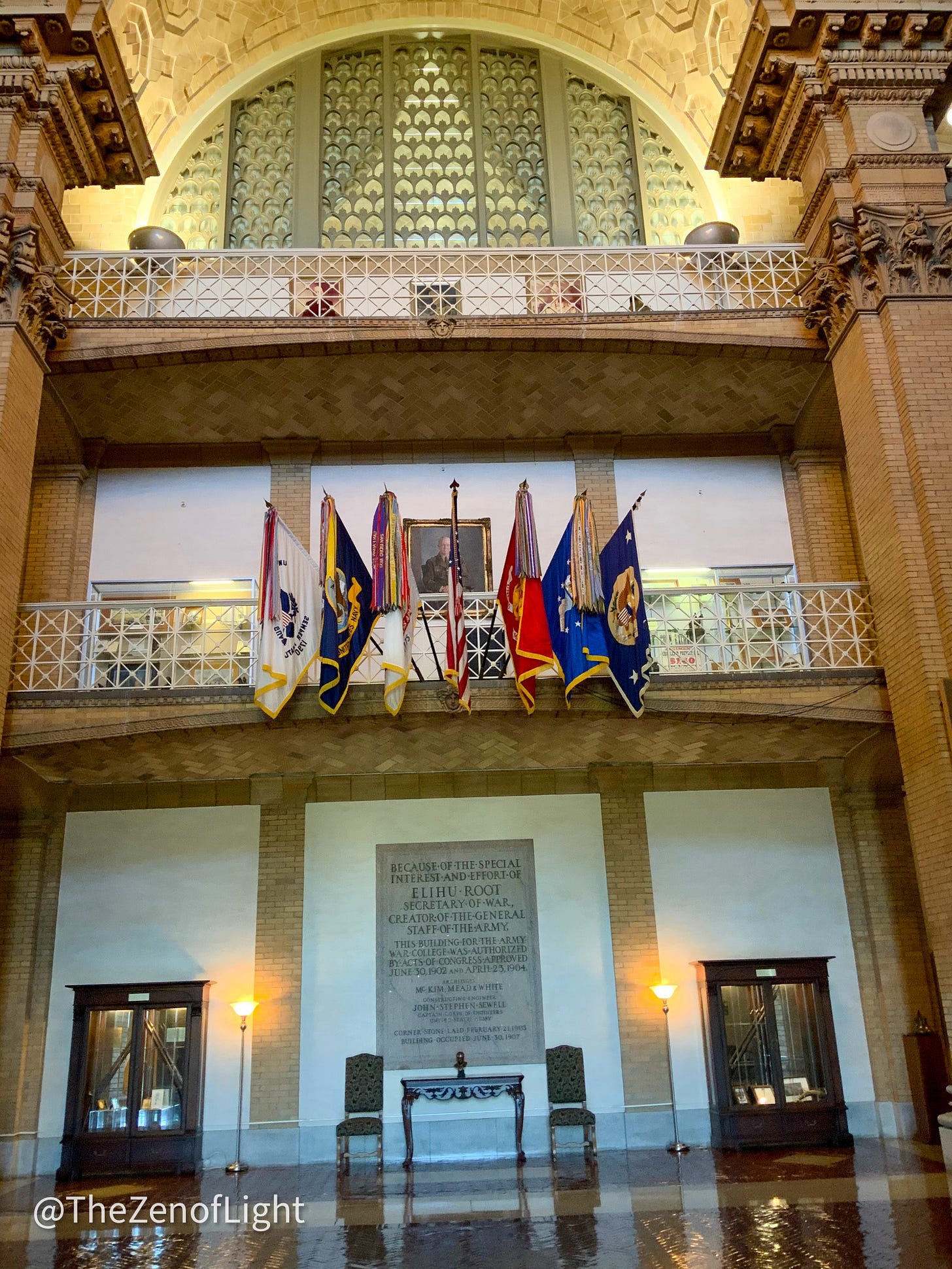It was a remarkable sunrise over Spa Creek this morning. Wishing each and every one of you a superb week. Summer is racing by.
The National War College is housed in Roosevelt Hall, an imposing structure at the southern tip of Fort Lesley J. McNair where the Anacostia and Potomac Rivers converge. Theodore Roosevelt laid the cornerstone for the building in 1904, unleashing the renowned architectural and engineering wizards McKim, Mead and White on their three year erection of this Beaux Arts treasure. Anyone flying in or out of National Airport sees this building to the east.
The Army War College occupied the building between 1907 until the creation of the National War College 39 years later.
interior and exterior views of the place match the beauty of any European building. It’s a shame that post-9/11 security concerns confine its visitors to people with Department of Defense credentials and their guests. If you have the chance to visit, definitely do so as it is your National War College.
Between 1997 and 1999, the NWC convened elsewhere because Roosevelt Hall desperately needed its first systemic maintenance. The fireplaces used when the building opened no longer functioned but doorways to offices matched the fireplace footprint, regardless where the office sat. An embarrassing but too common ‘decoration’ were the huge rubbish bins in the Rotunda to catch the voluminous leaks in that copper dome. We always hoped those links never shorted the dramatic chandelier dangling from the third deck over the Rotunda. The carpets were not original but terribly worn and frankly embarrassing in their threadbare state. The auditorium still had a slide projector in the middle of the room in 1997. As a former ambassador observed later of her alma mater, ‘it was pretty seedy’. It was not at its finest to put it mildly.
For 18 months, the College convened in a nearby unloved government facility. Leadership did its best to recreate the Roosevelt Hall environment to prevent the Class of 1998 for half its study and the entire ten months’ study of the Class of 1999 from feeling they were shortchanged. But, it wasn’t the same as there is no where like Roosevelt.
In delaying all of this maintenance for decades, the costs went up because lots of things had changed. A major area that our military faculty identified immediately was likely asbestos throughout the building which indeed was true. That meant all sorts of extra remediation. Oh, and that leaky copper roof? Turned out there was literally no one still alive in the United States who knew how to work on a roof of that type. It required specialised help from Italy.
Oh, and then there were the jurisdictional fights over building redesign. It wasn’t merely that we jettisoned the beloved (for some of us) chalk boards in favour of alleged ‘smart’ boards but we wanted to create different sized rooms for pegagogical and expanded enrollment reasons. Turned out that we could not do that without approval from District of Columbia historical offices, federal offices, and others I am forgetting totally a dozen. It was a nightmare to get them to agree on anything.
And the ceiling itself presented other challenges. Turned out the tile that McKim, Mead and White used has—repeat HAS—the same acoustical quality as the finest music venues in the world. One can whisper on the north side of Roosevelt’s third deck so someone all of the way across on the south side hears the comments as if whispered directly in one’s ear. How phenomenal. Except when one is operating in a ‘not-for-attribution’ environment where student comments could adversely affect their careers. Since the College’s mission strictly encourages them to throw off those concerns to think creatively to achieve national security solutions, it was incumbent on the redesigners to fix that. Ultimately an engineering masterpiece of a laser-created plexiglas divider was necessary. And on and on.
But what sticks most with me was the damage by neglecting the wide esplanade facing the parade ground in front of the building. That parade ground now becomes a spot for various helocopter landings that occasionally occur but the entrance is Roosevelt is so majestic to welcome heads of state and other dignitaries. But the freeze and thaw of D.C. winters and heavy rains over a century made it virtually unsafe.
The bricks were broken, chipped, and thus leaking into the lower level of the Hall. It was an unholy mess requiring the complete replacement of the thousands of bricks over months and months when we finally got the money. The downstairs offices had mold problems which meant they needed maintenance, too. This meant that the on-going rehab actually extended virtually a decade. It was more expensive, some of it dangerous, complicated, and frustrating as usage increased. But Congress, DoD, and other relevant parties other priorities were deemd more important. We could have paid more taxes, I suppose, but we don’t like to pay for things like maintenance apparently.
This all comes rushing to mind as I read this morning that the water hydrants were dry in Lahaina as the firefighters sought to quell the inferno last week. How could that be, I asked? I wonder if it was maintenance?
The infrastructure of the United States is still awaiting its refurb. The Build Back Better Act the Congress passed in 2022 is visibly working to rebuild transportion infrastructure in cities and towns across the country. That is not a partisan observation but a reflection on the impossibility of driving through the country right now without encountering road projects, woefully overdue, to fix aging bridges, improve road merges, and more to support ever-growing usage.
However, the infrastructure is not merely transportation. The power grid is aging and vulnerable to cyber interference, according to those who study these things. The air transportation grid, again according to stories earlier this spring, is rather fragile as periodic thunderstorms and computer failures make only too frustrating; I have to assume there are cyber risks there, too.
Cities do maintenance checks on sewer lines for a reason. How about on these other things?
It’s always easier to defer maintenance for annoyance and cost reasons. The reality is that can be shortsighted with all sorts of serious consequences as well as almost inevitably (not sure why I even caveat this) costing much more yet we have developed a mindset of ‘out of sight, out of mind’. It seems extremely risky is assuming none of these national issues have major dangers.
We care about those things we invest in. I hope we are investing as a society in all we care about as I know of few things that pay for themselves. When is it ever cheaper to rebuild anew instead of maintaining if that is our concern? FIN




